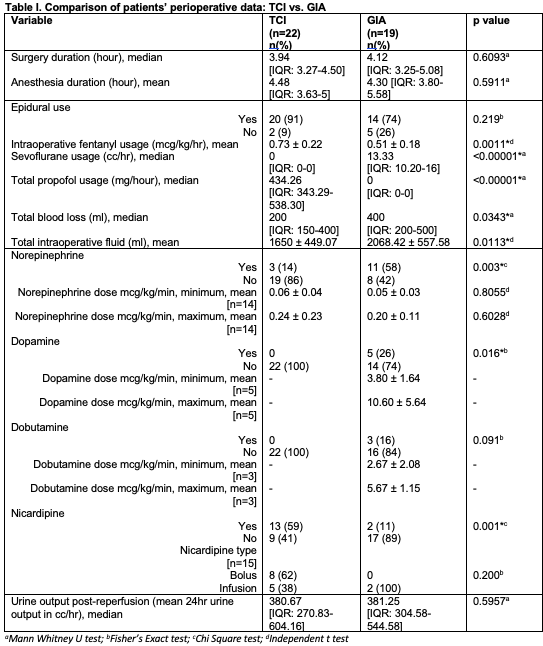Effect of target-controlled infusion versus general inhalational anesthesia on hemodynamic parameters and post-operative outcomes among renal transplant patients: a single-center, open-label, randomized controlled trial
Israel Del Mar Lim1, Luis R Aoanan1, Roan J Jocson1.
1Anesthesiology, National Kidney and Transplant Institute, Quezon City, Philippines
Introduction: Renal transplant in the Philippines is a growing treatment option for patients with end stage renal disease. General anesthesia using volatile anesthetics (i.e., sevoflurane) is typically given. Renal toxicity from gas anesthetics have raised concerns. Propofol, a sedative-hypotonic, can be given intravenously through a target-controlled infusion in-order to maintain anesthesia. Data regarding the advantages of gas versus gas-less anesthesia is limited in this subset of patients. This study aimed to compare the effect of target-controlled infusion (TCI) versus general inhalational anesthesia (GIA) on hemodynamic parameters and post-operative outcome among renal transplant patients.
Methods: A single-center, randomized controlled study in 41 patients for living renal allograft transplant was done. Patients were randomly allocated into either a TCI or GIA group. Hemodynamic parameters such as mean arterial pressure (MAP), cardiac index (CI) and stroke volume index (SVI) were recorded. Secondary outcomes (such as agitation scale, post-operative renal function, delayed graft function and complications) were also recorded.
Results: 22 patients underwent anesthesia under TCI while 19 were under GIA. Baseline demographic and clinical data (such as age, sex, body max index, comorbidities, Charlson comorbidity index, pre-operative creatinine and eGFR) was similar between the two groups. At all-time points, the study showed a non-significant difference between the two groups in MAP (p=0.7007), CI (p=0.2698) and SVI (p=0.5658) [Figure 1]. Mean fentanyl use was significantly higher in the TCI group (p=0.0011). Mean intraoperative fluid given was significantly lower in the TCI group (p=0.0113) [Table 1]. No significant difference in blood loss was noted in the per-protocol analysis. Patients under inhaled anesthesia utilized more vaso/ino-pressors while those under a gas-less technique required more vasodilators. 1 patient under TCI underwent hemodialysis on post-op day 5, 2 other patients required immediate re-opening due to hematoma formation. Conversely, 1 patient under GIA required immediate re-opening due to the same reason. Overall, secondary outcomes were non-significant between the two groups.


Conclusion: Target-controlled infusion using propofol is comparable to inhalational anesthesia in hemodynamic effect and post-operative outcome among renal transplant recipients. Aside from demonstrating perfusion stability, propofol is renal safe and environmentally friendly.
[1] hemodynamic parameter
[2] post-operative complication
[3] living renal transplant
[4] target-controlled infusion
[5] renal graft function
